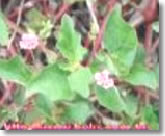
PIUNARNAVA
Botanical name: Boerhavia diffusa (NYCTAGINACEAE)
English Name: Spreading Hog weed, Pig weed
Hindi Name : Sant, Thikri

Introduction: Punarnava is one of the commonly used plants for immuno-modulation and nephroprotection in the Ayurvedic medicine. It is in vogue since vedic period. Charaka considered it as rejuvenat (Vayahsthapana). He quoted it among the leafy vegetables and today find this among the frequently consumed leafy vegetables in Tamil Nadu. It is described as Sotha hara (anti-inflammatory), Rasayana (anti-oxidant), Hridya (cardiotonic) etc.
Distribution : A perennial creping herb which is commonly found throughout India.
Chemical Constituents: beta-sitosterol, alpha-2-sitosterol, palmitic acid, archidic acid, hentriacontance, ursolic acid, hypoxanthine-9-arabinofuranoside, punarnavosie, two retenoids- boeravinone A, B, C,D, E & F, two new retenoids- repenone & repenol, bothavine etc.
Parts Used: Root.
Properties: Sweet-bitter-astringent, anti-inflammatory, diuretic, digestive etc.
Indication: CHF, urinary tract diseases, anaemia, heat diseases, inflammatory and non-inflammatory edema etc.
Does: Fresh juice 5-10 ml; power 1-3 g
Therapeutic Uses:
- Insomnia: Decoction of Punarnava is given orally.
- Inflammatory conditions: Ghee prepared with decoction as well as paste of Punarnava.
Scientific studies:
Cardivascular activity: Total alcoholic extract showed a cardiotonic effect in perfused frog heart preparation and anaesthetized dog heart in situ ( Bhalla et al., 1971). Hypoxanthine-9-arabinofuranoside produced depressor and negative chronotropic effects in rats and cat; it also produced negative chronotropic response in guinea pig isolated atrial mucle (Fitoterapia, 56 : p. 31, 1989). Liriodendrin exhibited significant calcium chnnel antagonistic effect in frog heart single cell ( Chem. Pharm. Bull., 39: p. 1551, 1991). It is found to be source of calcium channel blocker ( Aftab et al., 1996).
Antistress activity: The alkaloidal fraction of root was found to possess restorative activity against stress induced changes in plasma and adrenal cortisol levels. It also significantly augmented the antinbody production in stressed rats as compared to control ( Mungantiwar et al., 1997).
Antioxidant activity: It produced 50% inhibition of lipid peroxidation at a concentration of 2.28 mg/ml and 1.84 mg/ml in Fe2 + ascorbate system (Joy & Kuttan, 1995).
Hepatoprotective activity: Chloroform and mathanolic extracts of roots and aerial parts exhibited hepartoprotective activity against CC14-intoxication in rats; a rotenoid, a steroid and a flavone retaining hepatoprotective activity were also obtained ( Indian Drugs, 27: p. 161, 1989).
Cultivation Technology: It grows best in sandy-loam to loam soils. Seeds are sown in well-ploughed raised beds in the month of July-August. Later, these plants are transplanted to the ridges at the spacing of 15x15 cm or 30x30 cm. Irrigate the field immediately after transplanting or as and when required.
Harvesting: Plant can be harvested after 2-3 years of plantation. Roots are dug out cleaned and cut longitudinally for drying. Seeds can be collected in the month of October-November.







